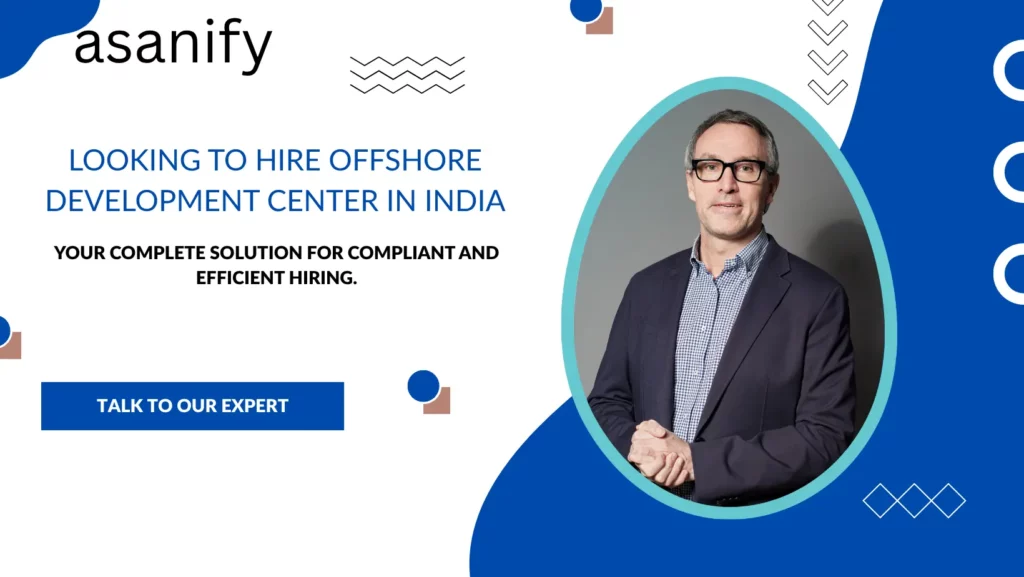Discover how to set up an offshore development center in India, its benefits, costs, and why global companies choose India for scalable tech teams in 2025.
Offshore Development Center in India: What You Need to Know
What is an Offshore Development Center (ODC)?
An Offshore Development Center is a dedicated tech team in a foreign country working exclusively on your company’s projects of your own. Unlike traditional outsourcing, where an external third party vendor is temporarily assigned tasks; ODCs work as an extension of your in-house team where you remain in full control of the workflows, priorities, and output of the team.
These days, ODCs are particularly favored by fast-growing tech companies that need to scale quickly while building product development teams for efficiency, quality, and control.
Points of distinction between an ODC and traditional outsourcing:
- Ownership: ODC teams are dedicated to you; outsourcing firms frequently provide services to multiple clients.
- Control: ODCs provide more visibility to its end customer and better alignment with company culture and processes.
- Longevity: ODCs bring long-term value with continuous development, focusing on the delivery of short-term objectives.
Why Choose India for Your Offshore Development Center?
- Access to a huge pool of English-speaking tech talent: India produces over a million STEM graduates every year, making it a powerhouse where developers, testers, and engineers are nurtured.
- Massive cost savings (40–70% lower than US/Europe): Labor costs are very affordable in India, without compromising on the quality of the service being rendered, thus helping you extend your runway and invest even more into your product.
- Strong IT infrastructure and government support: With tech parks, reliable internet connectivity, and government-friendly policies, India encourages foreign investments into IT services.
- Cultural compatibility with Western teams: Indian teams tend to collaborate well with Western organizations because they understand Western business practices and time zones, and communication styles.
- Global experience with agile development practices: Indian ODCs are in the forefront in terms of the implementation of Agile, Scrum, and DevOps methodologies- the very nerve of product teams today.

Who Should Consider Setting Up an Offshore Development Center in India?
- Tech startups scaling engineering under low cash burn
- SaaS companies building long-term product teams
- Enterprises embarking on digital transformation projects
- Agencies requiring dedicated resources for mobile and web app development
If you require long-term full-time engagement to support your development roadmap, India-based ODCs are a good choice.
Suggested Read: Hire AngularJS Developers in India: The Ultimate 2025 Guide
Popular Locations for Offshore Development Centers in India
The country offers a host of cities with great tech ecosystems and different tech talent pools. Your choice of the ideal location might hinge upon team-size requirements, niche skills, and budget constraints.
Top Cities:
- Bangalore – Calling itself India’s Silicon Valley, Bangalore today, is home to the top global tech giants as well as rich startup ecosystems.
- Hyderabad – A city with engineering prowess, thereby, particularly for AI, ML, and enterprise solutions.
- Pune – With access to some of the best universities gives quite a thriving IT services industry.
- Chennai – The city famous for good infrastructure and cheap talent.
- Gurgaon/Noida – Located near New Delhi, with ready tech parks and a blend of enterprise and startup talent present.
Team Structure in a Typical Offshore Development Center
| Role | Responsibility |
| Project Manager | Oversees delivery, sprint planning, and team coordination |
| Developers (Frontend/Backend/Full Stack) | Write, test, and maintain application code |
| QA Engineers | Conduct manual and automated testing to ensure quality |
| UI/UX Designers | Design intuitive interfaces and improve user experience |
| DevOps Engineers | Handle CI/CD, infrastructure, and deployment pipelines |
How to Set Up an Offshore Development Center in India
Step-by-Step Process:
- Define objectives and location
Determine your tech requirements, team size, and preferred city (such as Bangalore, Pune, or Hyderabad). - Select setup model
Set up either your own entity or an ODC provider or EOR for quicker go-live. - Employ your core team
Hire developers, project managers, and designers with local hiring assistance. - Establish infrastructure
Secure office space (if required), tools, HR, and payroll infrastructure. - Create workflows and KPIs
Synchronize on sprint cycles, reporting, and performance metrics on day one.
Cost of Running an Offshore Development Center in India
Sample Monthly Salary Benchmarks (USD):
| Role | Junior | Mid-Level | Senior |
| Developer | $800 | $1,500 | $2,500 |
| QA Engineer | $700 | $1,200 | $2,000 |
| UI/UX Designer | $900 | $1,400 | $2,200 |
| Project Manager | $1,500 | $2,200 | $3,500 |
These figures reflect averages in top cities like Bangalore, Hyderabad, and Pune and can vary slightly based on location and niche skillsets.
Suggested Read: Hire Codeigniter Developers in India: The Ultimate 2025 Guide
ODC vs Traditional Outsourcing: What’s the Difference?
Choosing between an Offshore Development Center and traditional outsourcing depends on your project goals, desired control, and budget.
Here’s a quick comparison:
| Aspect | ODC (Offshore Development Center) | Outsourcing |
| Team Ownership | Full-time dedicated team | Project-based vendor team |
| Collaboration | Direct daily communication, full integration | Limited interaction |
| Scalability | High – scale teams as needed | Moderate |
| Cost | Medium-high upfront, better long-term ROI | Lower short-term, less control |
ODCs are ideal for long-term, product-focused initiatives where team alignment and consistency matter, while outsourcing is more suited for short-term or one-off projects.

Legal and Compliance Considerations in India
Establishing and operating an Offshore Development Center in India demands attention to detailed legal and compliance considerations. Failure to pay heed to them can result in fines, IP exposure, or employee conflict.
Major Legal Considerations:
1. IP transfers and ownership agreements: Make sure you have unambiguous contracts in place to safeguard your codebase, product IP, and inventions developed by your offshore team.
2. Data protection and NDA enforcement: Enforce strict non-disclosure agreements (NDAs) and data handling policies to comply with GDPR, HIPAA, or other regulatory requirements.
3. Compliance with Payroll (PF, ESI, TDS: Indian employees are eligible for social security benefits such as Provident Fund (PF), Employee State Insurance (ESI), and tax deduction at source (TDS). All of these have to be processed accurately and on time.
4. Labour laws and holiday policy: India has both national and state-level labor laws. Take note of compulsory leaves, public holidays, and working hours.
Challenges in Managing Offshore Development Centers
- Talent retention – Excessive attrition in tech centers implies that you have to have high engagement and career progression.
- Time zone management – Scheduling across India-US or India-Europe time zones might lead to delays unless planned out.
- Culture and communication gaps – Varying work styles or unclear communication can affect productivity.
- Scaling the team quickly – Hiring good talent quickly may be challenging without local hiring assistance.
Best Practices to Manage Your ODC in India Successfully
- Take advantage of collaboration tools
Utilize tools such as Jira, Slack, and GitHub to automate task tracking, communication, and code management.
- Perform weekly demos and async updates
Publish project updates through Loom, Notion, or video calls to provide transparency and feedback loops—particularly across time zones.
- Celebrate cultural milestones
Recognize Indian festivals such as Diwali and Holi to promote inclusion and morale.
- Provide perks and growth trajectories
Offer such perks as learning budgets, flexible work arrangements, and career growth to attract and retain best talent.

Should You Use an ODC Provider or Build In-House?
Deciding between setting up your own legal entity and partnering with an Offshore Development Center (ODC) provider depends on your growth stage, budget, and need for control.
| Option | Pros | Cons |
| ODC Partner/Provider | Fast setup, No legal overhead, Managed HR/payroll | Limited control, Shared employer branding |
| Own Legal Entity | Full control, Better brand alignment | Slower setup, Complex compliance |
FAQs: Offshore Development Center in India
An ODC is a dedicated, full-time team located in a foreign country (like India), working exclusively for your business.
India offers a massive talent pool, cost advantages, strong infrastructure, and cultural compatibility with Western companies.
Monthly salaries typically range from ₹60,000 for junior developers to ₹2.5 lakhs for senior roles. Including infrastructure and HR costs, running an ODC is still 50–70% cheaper than hiring in the US or Europe.
Key benefits include lower costs, access to tech talent, faster hiring, and scalable operations with full team control.
An ODC offers a dedicated team and long-term collaboration, unlike outsourcing, which is often project-based and time-limited.
Conclusion
India is the world’s go-to destination for establishing Offshore Development Centers—due to its cost-effectiveness, skilled talent, and solid digital infrastructure. Whether you’re a lean startup wanting to scale or a large enterprise spearheading global innovation, creating an ODC in India provides a strategic edge in today’s competitive technology environment.
Not to be considered as tax, legal, financial or HR advice. Regulations change over time so please consult a lawyer, accountant or Labour Law expert for specific guidance.

